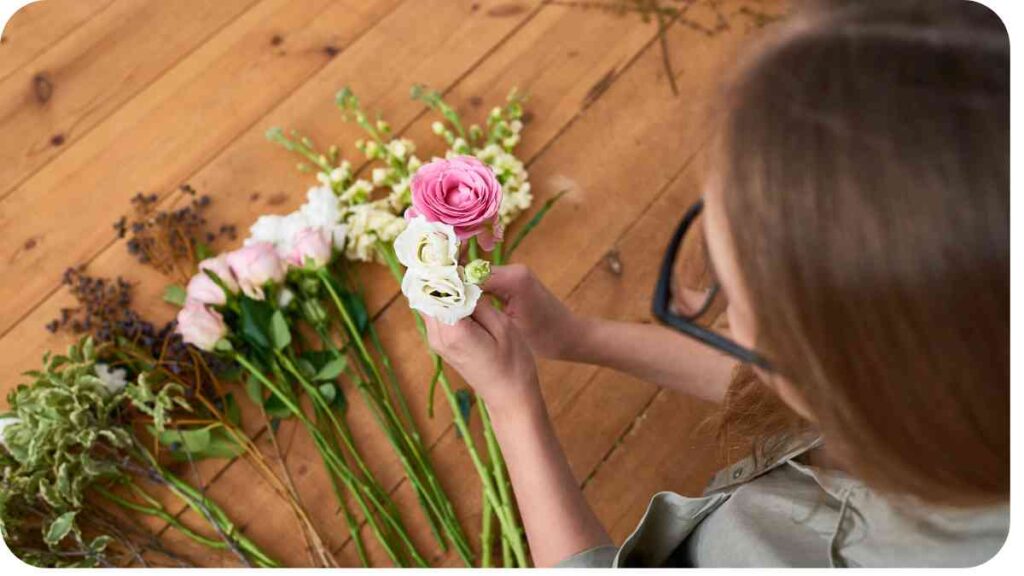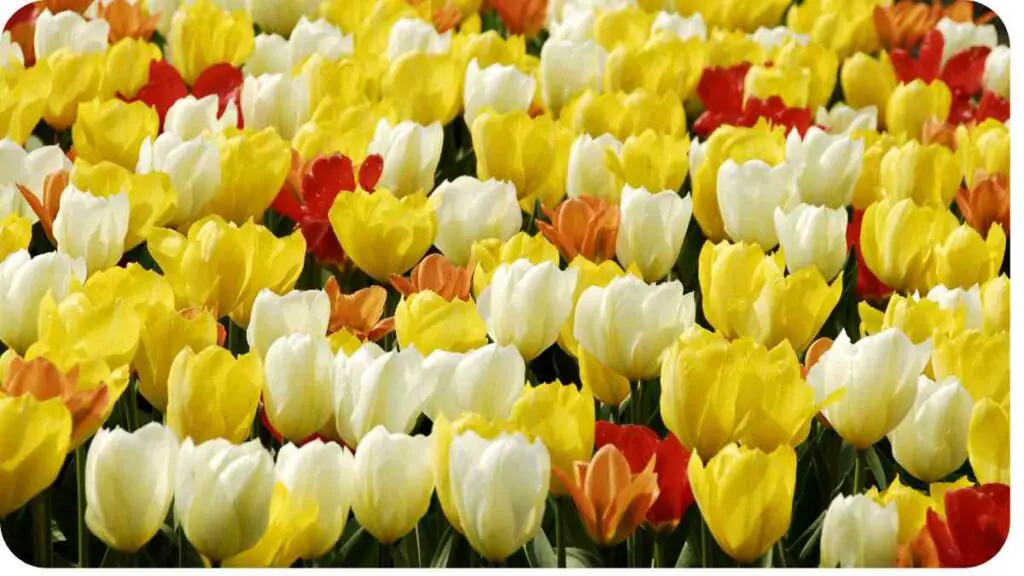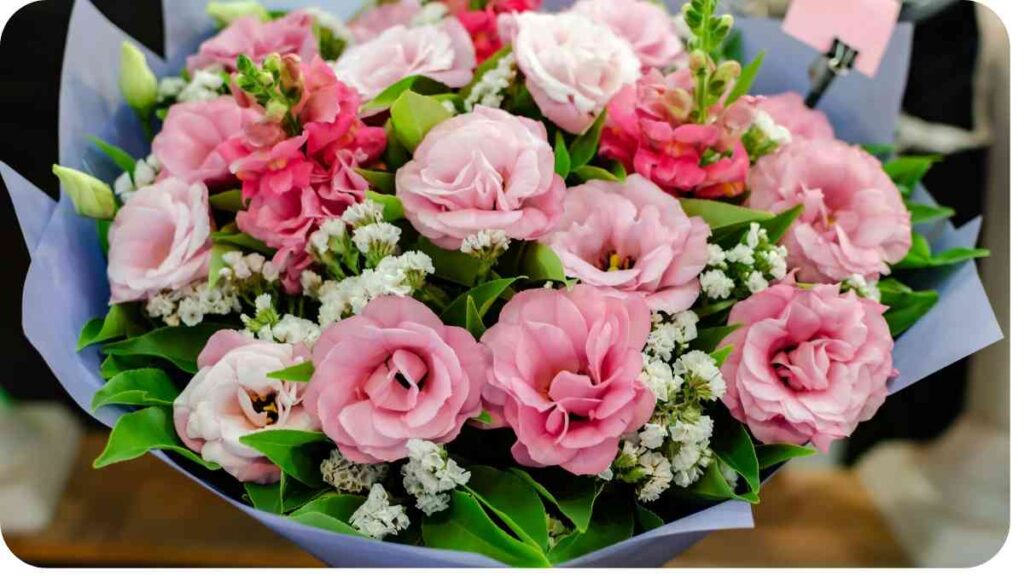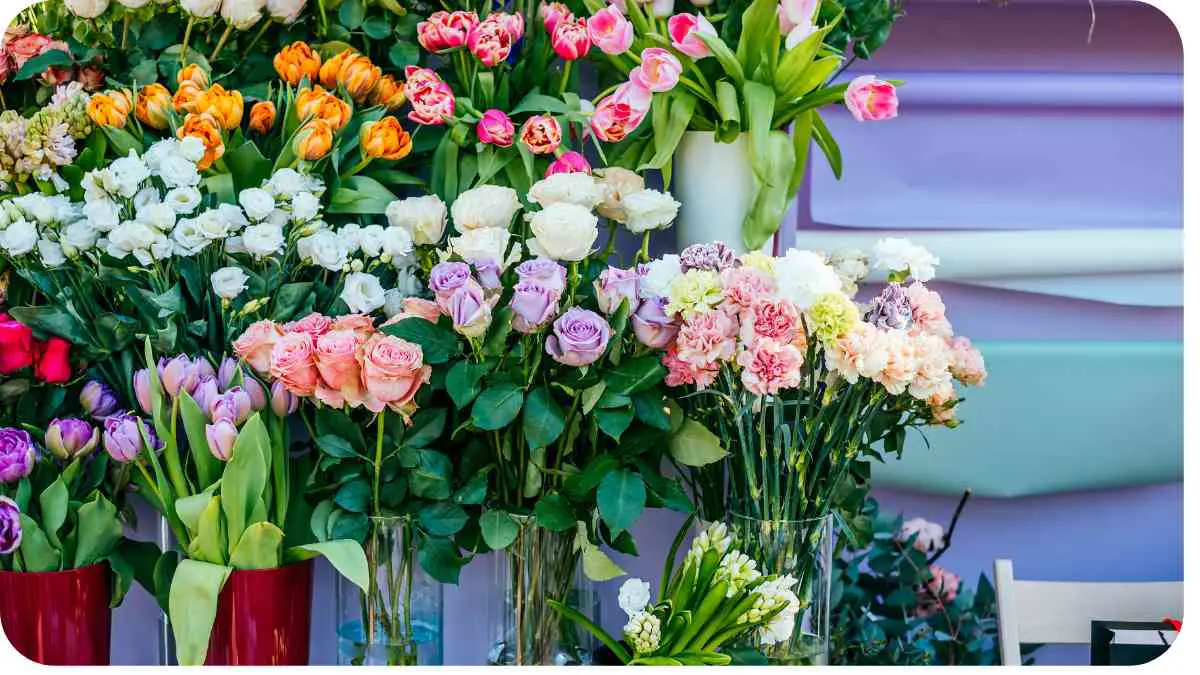Flowers have always held a special place in human culture, symbolizing beauty, love, and celebration. Whether it’s for weddings, birthdays, or simply to brighten someone’s day, the art of bouquet arrangement transforms individual blooms into stunning floral masterpieces.
In this guide, we’ll delve into the intricacies of floral design, explore the techniques behind creating captivating bouquets, and provide tips for selecting the perfect blooms for any occasion.
| Takeaways |
|---|
| Understand the symbolism of different flowers and how they convey messages. |
| Master the basic principles of bouquet arrangement and have the right tools. |
| Choose flowers based on color harmony, seasonality, and texture considerations. |
| Learn various flower arranging techniques to unleash creativity. |
| Explore different bouquet styles and customize them for special occasions. |
| Extend the lifespan of bouquets with simple preservation techniques. |
| Incorporate unique elements to add personality and flair to your bouquets. |
| Utilize online resources for inspiration and further learning. |
1. Understanding Floral Design

Floral design is more than just arranging flowers; it’s about creating harmonious compositions that evoke emotion and captivate the senses. Different flowers carry distinct meanings and symbolism, making them powerful tools for conveying messages and setting the tone for an event.
In Fort Lauderdale, floral artistry blooms with vibrant creativity, offering a diverse range of flower arrangements that capture the essence of local beauty.” Local Floral Artistry
Table 1: Types of Flowers and Their Meanings
| Flower | Meaning |
|---|---|
| Roses | Love, passion, romance |
| Lily | Purity, innocence, renewal |
| Orchid | Luxury, beauty, strength |
| Sunflower | Happiness, vitality, adoration |
| Tulip | Elegance, grace, abundance |
2. The Basics of Bouquet Arrangement
Creating a stunning bouquet begins with understanding the basic principles of arrangement and having the right tools at your disposal. From selecting a suitable vase to mastering the art of flower placement, attention to detail is key to achieving a cohesive and visually appealing result.
Table 2: Essential Tools for Creating Bouquets
| Tool | Purpose |
|---|---|
| Floral shears | For cutting stems |
| Floral tape | Secures stems together |
| Floral foam | Provides support and hydration |
| Vase or container | Holds the bouquet |
| Ribbon | Adds decorative touch |
3. Choosing the Right Flowers
Selecting the perfect flowers for your bouquet involves more than just picking your favorites. Consideration should be given to factors such as color scheme, seasonality, and the overall theme of the event. By choosing blooms that complement each other, you can create a cohesive and visually striking arrangement.
Discover a blooming oasis as you explore the art of cutting flower garden plants, cultivating a colorful tapestry of nature’s finest blooms.” Blooming Oasis
Table 3: Seasonal Flowers and Their Availability
| Season | Popular Flowers |
|---|---|
| Spring | Tulips, daffodils, peonies |
| Summer | Roses, sunflowers, dahlias |
| Autumn | Chrysanthemums, asters, zinnias |
| Winter | Poinsettias, amaryllis, holly |
4. Color Harmony in Bouquets

Color plays a crucial role in bouquet design, as it can evoke different emotions and set the mood for an event. Understanding color theory and how various hues interact is essential for creating harmonious arrangements that captivate the eye.
Table 4: Color Wheel and Flower Color Combinations
| Color | Meaning | Complementary Colors |
|---|---|---|
| Red | Passion, love | White, pink |
| Yellow | Joy, happiness | Purple, blue |
| Blue | Tranquility, peace | Orange, yellow |
| Pink | Romance, sweetness | Green, white |
| Purple | Luxury, elegance | Yellow, white |
5. Texture and Shape Considerations
Texture and shape are important elements that add depth and visual interest to bouquets. By incorporating a variety of textures, such as soft petals, delicate foliage, and bold accents, you can create dynamic arrangements that appeal to both the eyes and the senses.
Table 5: Textural Elements in Bouquets
| Texture | Description | Examples |
|---|---|---|
| Soft | Smooth and delicate | Roses, peonies |
| Fuzzy | Velvety or hairy | Lamb’s ear, celosia |
| Spiky | Sharp or prickly | Thistle, eryngium |
| Ruffled | Frilly or crinkled | Ranunculus, lisianthus |
| Glossy | Shiny and reflective | Eucalyptus, magnolia leaves |
6. Adding Foliage and Fillers
Foliage and fillers play a supporting role in bouquet arrangements, providing structure, texture, and contrast to the main blooms. From lush greenery to delicate accents, the right foliage can enhance the overall aesthetic and add depth to your creations.
Celebrate the arrival of spring with a vibrant tulip bouquet, a delightful arrangement that embodies the beauty and joy of the season.” Spring Celebration
Table 6: Common Foliage and Filler Options
| Foliage/Filler | Description | Examples |
|---|---|---|
| Eucalyptus | Fragrant, silvery-green foliage | Baby blue, silver dollar |
| Ferns | Feathery and delicate | Maidenhair, leatherleaf |
| Baby’s breath | Small, delicate white flowers | Gypsophila |
| Lavender | Fragrant purple blooms | English, French |
| Leatherleaf | Sturdy, dark green foliage | Common foliage filler |
7. Techniques for Arranging Flowers
Mastering various flower arranging techniques is essential for creating professional-looking bouquets. From the classic round arrangement to more intricate designs like cascading or hand-tied bouquets, understanding these techniques allows you to unleash your creativity and bring your floral visions to life.
Table 7: Flower Arranging Techniques
Bouquets come in various styles, each with its own unique aesthetic and charm. Whether you prefer a classic, romantic look or a modern, minimalist design, there’s a bouquet style to suit every taste and occasion.
Table 8: Comparison of Bouquet Styles
| Style | Description | Ideal for |
|---|---|---|
| Round | Compact and symmetrical | Weddings, formal events |
| Cascade | Dramatic, with flowers flowing downward | Bridal bouquets |
| Hand-tied | Loose and natural, tied with ribbon | Everyday arrangements |
| Posy | Small and delicate, perfect for handheld | Bridesmaids, prom |
| Pomander | Flowers arranged in a ball-shaped bouquet | Flower girls, ceremonies |
9. Tips for Extending the Lifespan of Bouquets
After putting effort into creating a beautiful bouquet, it’s essential to ensure it stays fresh and vibrant for as long as possible. By following some simple tips and tricks, you can maximize the lifespan of your floral arrangements and enjoy their beauty for days to come.
Table 9: Flower Preservation Techniques
| Tip | Description |
|---|---|
| Trim stems regularly | Keep stems submerged in water, cut at an angle |
| Change water every few days | Prevents bacterial growth and keeps flowers hydrated |
| Remove wilted blooms | Prevents ethylene production and extends bouquet life |
| Keep away from direct sunlight | Prolongs freshness and prevents wilting |
| Use flower food or homemade preservative | Provides nutrients and helps flowers last longer |
10. Incorporating Unique Elements
Adding unique elements to your bouquets can elevate them from ordinary to extraordinary. Whether it’s incorporating unconventional materials like feathers or incorporating personal touches like family heirlooms, these special additions can make your bouquets truly one-of-a-kind.
Table 10: Unique Additions to Bouquets
| Element | Description | Examples |
|---|---|---|
| Feathers | Adds texture and whimsy to arrangements | Peacock, ostrich |
| Brooches | Vintage or decorative pins | Family heirlooms, statement pieces |
| Succulents | Durable and low-maintenance | Echeveria, aeonium |
| Ribbons | Adds color and movement | Silk, velvet |
| Crystals | Sparkling accents for added glamour | Swarovski, quartz |
11. Designing for Special Occasions
Each special occasion calls for a unique bouquet that reflects the mood and theme of the event. Whether it’s a wedding, anniversary, or graduation, tailoring your bouquet to suit the occasion adds a personal touch and enhances the overall experience for both the giver and the recipient.
Master the art of creating floral masterpieces, where creativity blossoms and the beauty of bouquet crafting comes to life in every arrangement.” Floral Masterpieces
Table 11: Bouquet Ideas for Various Events
| Occasion | Bouquet Style | Flower Choices |
|---|---|---|
| Wedding | Cascading or round bouquet | Roses, peonies, hydrangeas |
| Anniversary | Romantic and elegant arrangement | Calla lilies, orchids, roses |
| Birthday | Bright and cheerful bouquet | Gerbera daisies, sunflowers |
| Graduation | Modern and minimalist design | Succulents, tropical blooms |
| Valentine’s Day | Classic red roses bouquet | Red roses, tulips, carnations |
12. DIY vs. Professional Bouquet Services

When it comes to creating bouquets, you have the option to either DIY or enlist the help of professional florists. Both approaches have their pros and cons, and the decision ultimately depends on factors such as budget, time constraints, and personal preferences.
Table 12: Pros and Cons of DIY and Professional Services
| Aspect | DIY Bouquets | Professional Services |
|---|---|---|
| Cost | Lower cost, especially for smaller arrangements | Higher cost, includes labor and expertise |
| Customization | Full control over design and flower selection | Limited customization, based on florist’s expertise |
| Time | Time-consuming, requires preparation and skill | Convenient, saves time and effort |
| Expertise | Limited floral knowledge may affect outcome | Professional expertise ensures high-quality results |
| Stress | Potential stress from arranging flowers | Less stress, leave it to the experts |
13. Finding Inspiration and Resources
Whether you’re a seasoned florist or a novice enthusiast, finding inspiration for your bouquet designs is essential for staying creative and innovative. Fortunately, there are plenty of online resources, communities, and workshops dedicated to floral artistry that can help spark your imagination and hone your skills.
Express your condolences with the perfect bouquet, selecting from a curated collection of flowers designed to convey sympathy and comfort.” Guide for Condolences
Table 13: Online Resources for Floral Inspiration
| Resource | Description |
|---|---|
| Visual platform with endless bouquet ideas | |
| Explore hashtags like #floraldesign for inspiration | |
| YouTube | Tutorials and demonstrations on bouquet arranging |
| Floral design blogs | Websites like Floret Flowers offer tips and insights |
| Online courses | Platforms like Skillshare offer floral design courses |
14. Conclusion
Creating floral masterpieces is both an art and a science, requiring creativity, skill, and a deep appreciation for nature’s beauty. By understanding the principles of floral design, mastering various arrangement techniques, and incorporating unique elements, you can create bouquets that not only captivate the eye but also touch the heart.
Whether you’re arranging flowers for a special occasion or simply to brighten someone’s day, remember that the true essence of bouquet creation lies in the joy it brings both the creator and the recipient. So, let your imagination bloom and unleash your creativity as you embark on your journey to become a master of floral artistry.
Further Reading
- Coursesidekick: Floral Design Courses: Explore a variety of online courses dedicated to floral design, ranging from beginner to advanced levels.
- Bloom Magic Flowers: Floral Color Combinations: Discover tips and inspiration for creating stunning floral arrangements using color theory and combinations.
- Designboom: Harriet Parry’s Flower Interpretations: Dive into the world of contemporary floral art with Harriet Parry’s unique interpretations of flowers and botanicals.
FAQs
What are some essential tools for bouquet arrangement?
- Essential tools for bouquet arrangement include floral shears, floral tape, floral foam, a vase or container, and ribbon.
How do I choose the right flowers for my bouquet?
- When choosing flowers for your bouquet, consider factors such as color scheme, seasonality, and the overall theme of the event.
What techniques can I use for arranging flowers?
- Various techniques for arranging flowers include round arrangements, cascading bouquets, hand-tied bouquets, nosegays, and composite arrangements.
How can I extend the lifespan of my bouquets?
- To extend the lifespan of your bouquets, trim stems regularly, change water every few days, remove wilted blooms, keep away from direct sunlight, and use flower food or homemade preservatives.
Where can I find inspiration for bouquet designs?
- You can find inspiration for bouquet designs from online resources such as Pinterest, Instagram, YouTube, floral design blogs, and online courses.

I am Hellen James, a landscape architect. For many years I have written about landscaping for various publications; however, recently decided to focus my writing on personal experience as a profession.

